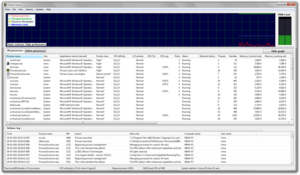Process Lasso
Process Lasso is a process priority optimizer for Windows developed by Jeremy Collake of Bitsum LLC. It features a graphical user interface that allows for automating various process related tasks (e.g. automatically restart process if X, or start High Performance power scheme when running, or restrain if out of control). Its ProBalance algorithm works by dynamically adjusting the processes priorities, in order to keep the system responsive when process(es) are consuming too many CPU cycles. [3]
 Interface of Process Lasso version 5.0.0.36 | |
| Developer(s) | Bitsum LLC (Jeremy Collake) |
|---|---|
| Stable release | 9.3.0.44 (August 25, 2019[1]) [±] |
| Operating system | Windows XP, Windows Vista, Windows 7, Windows 8, Windows 10[2] |
| Type | Utility software |
| License | Freemium |
| Website | bitsum |
A graphical CPUEater demo is available that shows ProBalance in action. Further, information is provided on how the algorithm works, and how the demo can be reproduced, or real-world scenarios that show similar effectiveness on restoring system responsiveness when a CPU heavy background process is inhibiting use of the PC.
One can also set processes exclusions, disallow programs from running, and amongst other features.[4] The paid version (Pro version) has some extra features, like setting a max number of instances per process, and the ability to run the core as a system service.[5]
Process Lasso is not a task manager replacement. It has some task manager capabilities, but the intent is to optimize and automate.
Features
Among this program's features are the following:[6]
- ProBalance (Dynamic priority and affinity optimization)
- SmartTrim (selective 'intelligent' virtual memory trimming)
- Gaming Mode 2.0 - A new maximum performance mode that disables CPU core parking and frequency scaling (new in 7.8).
- Persistent priorities and CPU affinities
- Auto-terminate
- Process Watchdog
- Instance Count Limits
- Limit Application CPU Use
- Balance Application Instances
- Multi-Core Optimization
- I/O priorities (persistent or temporary)
- Power Scheme Automation
- System Responsiveness Metric
- Independent Core Engine
- Minimal Resource Use
- Fully compatible with Windows 10
- Available in x86-32(bit) and x86-64(bit) builds
- Current version supports systems running up to 64 CPU cores; logical or in Hyper-Threaded mode.
Users who take advantage of the programs advanced features; such as assigning persistent priority class and CPU affinities to services or programs which are CPU intensive should fully familiarize themselves with Process Lasso's documentation. While optimizing and parking specific services and programs CPU cores and fine tuning priority classes can enhance system performance; a user could lock their system into "full load" by incorrectly elevating a service or program which makes use of multi-threading; where by the program can make the system; including mouse and keyboard actions non-responsive.
Reception
The program was featured on FreewareBB,[7] and received an "Excellent" rating from Softpedia, as well as a certification for containing no malware.[8]
The application has a 4.63 rating (out of a possible 5) at MajorGeeks.com.
Editors at CNET gave it 'Outstanding', 4.5 of a possible 5 stars. [9]
References
- https://bitsum.com/changes/processlasso/
- "Bitsum. Real-time CPU Optimization and Automation". Archived from the original on 2013-04-22. Retrieved 2011-05-27.
- "About ProBalance". Bitsum.com. 2015-01-22. Retrieved 2015-01-22.
- "Process Lasso the Windows process priority optimizer!". Bitsum.com. 2008-10-24. Archived from the original on 2013-04-22. Retrieved 2011-05-27.
- "Bitsum Technologies - Process Lasso Pro". Bitsum.com. 2011-02-22. Retrieved 2011-05-27.
- "How Free is Free? What is Freemium?". 2015-08-06.
- "Free Download Process Lasso 3.60 - Freeware Software". Freewarebb.com. Retrieved 2011-05-27.
- "Process Lasso Review - Process Lasso Download". Softpedia. Retrieved 2011-05-27.
- "Process Lasso".
External links
- Process Lasso - Process Lasso Official website